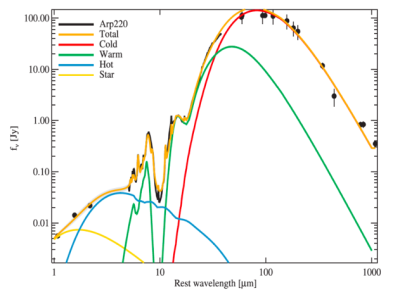Understanding The Physics Of U/LIRGs With Spitzer
Luminous and ultraluminous infrared galaxies (LIRGs/ULIRGs) have been an active area of galaxy research since their discovery more than three decades ago. With its vast increase in sensitivity in the infrared, Spitzer played a major role in exploring these galaxies in the local Universe, and at high redshifts.

In a review published in Nature Astronomy, L. Armus and B.T. Soifer of Caltech (USA) and Vassilis Charmandaris of IA-FORTH and the Univ. of Crete, highlight some of the major discoveries made with the Infrared Spectrograph (IRS) on Spitzer, through observations of luminous and ultraluminous infrared galaxies from the local universe to cosmic noon. These include measuring the role of starbursts and actively accreting supermassive black holes as power sources, finding evidence for energetic feedback on the atomic and molecular interstellar gas and dust and identifying the physical properties of luminous infrared galaxies on and off the galaxy star-forming main sequence.
Studies of low-redshift LIRGs and ULIRGs with Spitzer produced powerful new infrared tools and spectral templates for understanding the energy sources, dynamics, and multi-phase interstellar media in normal and active galaxies at all redshifts. The rise of composite starburst and AGN sources in galactic mergers, direct evidence for energetic feedback on the host ISM, and connections between infrared source compactness and the galaxy main sequence were all Spitzer successes.
However, limitations in the spatial and spectral resolution of Spitzer left unanswered questions about how star formation proceeds under such extreme conditions, and how SNe and AGN interact with and affect gas on sub-kpc physical scales. Even using the high-resolution IRS spectra, dynamic studies were restricted to extremely fast-moving gas, giving us a biased view of feedback. The spatial resolution, even in the nearest ULIRGs, was ~1-2 kpc at best, averaging over tens or hundreds of star forming regions and providing limits to the sizes and energy densities in the centers of these galaxies. At high redshifts, estimates of the power sources in SMGs and DOGs were often based on single features averaged over entire galaxies, and with relatively low signal to noise.
The James Webb Space Telescope is poised to provide our clearest look yet at the detailed physics operating inside ULIRGs at z < 2, and enable us to build and explore samples of galaxies in place well before the peak epoch of star formation. The Mid Infrared Imager Instrument (MIRI) provides an example of the leap in capabilities expected on JWST. MIRI covers slightly less wavelength than the IRS on Spitzer, but it is roughly 50 times more sensitive and it has a spectral resolving power ~5 times higher, and a spatial resolution nearly 10 times better than Spitzer.
Article: L. Armus, V. Charmandaris, B. T. Soifer, "Observations of luminous infrared galaxies with the Spitzer Space Telescope", Nature Astronomy, Vol. 4, pages 467–477 (2020)
